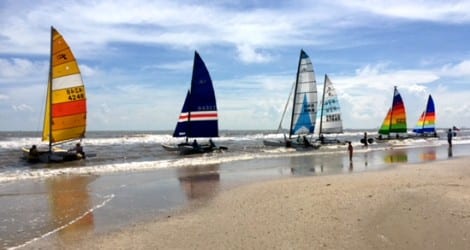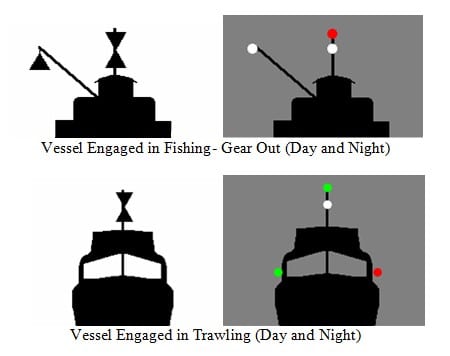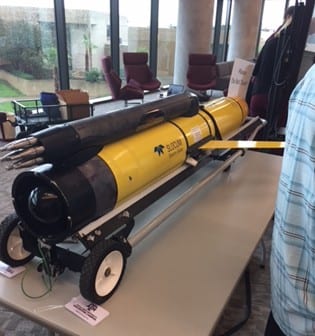 By Bob Currie, Vessel Examiner
By Bob Currie, Vessel Examiner
United States Coast Guard Auxiliary Flotilla 081-06-08
Hardheads 4th Annual Bolivar Rig Run
There is nothing more exciting on the water than a sailing regatta, and the Hardheads 4th Annual Bolivar Rig Run catamaran race was no exception to the rule. We have all seen sailboats on our waters, and they are fun to watch. But when a group of sailboats run in close proximity to each other and race to a point off shore and return to the beach, we get to witness the full magnitude of the sailors’ knowledge, skills and abilities.

The start of the race. Photo by Bob Currie
The sailors in this race had to head to a point due south of their starting point with a moderate east wind pushing them towards the north jetties, then turn into the wind and round our near rig, some three miles offshore, and then return to the starting point. They had 1-2 foot seas and an uncooperative shrimp boat to contend with, but the boats were all back on shore in just a little over an hour, having completed the course with no incidents. The winner reached shore in 51 minutes. Sadly, at the start of the race one boat lost a rudder on a sandbar and had to drop out. What made this regatta so exciting is that it consisted of a course that allowed the spectators on the beach to keep the boats in view for the entire race and follow each boat’s progress. As the saying goes, a good time was had by all. I was honored to provide a safety message to the contestants before the race began.
Flotilla 081-06-08 is based at Coast Guard Station Galveston. The Coast Guard Auxiliary is the uniformed civilian component of the US Coast Guard and supports the Coast Guard in nearly all mission areas. The Auxiliary was created by Congress in 1939. For more information, please visit www.cgaux.org.
People who are not experienced sailors often do not fully understand the Navigational Rules of the Road that apply to sailing vessels, so this column will be dedicated to explaining some of those rules. I have often heard people say that a sailboat always has the right of way, but as you will see below, that is not the case.
Navigational Rule 3 – General Definitions
The following list of definitions is not complete. I have just selected a few that will help in understanding the other rules. My own comments and further explanations are in parentheses. Certain vessels are required to display dayshapes during the day and lights at night, and I will mention some of the patterns that may be used.
(a) The word “vessel” includes every description of watercraft, including non-displacement craft, WIG craft, and seaplanes, used or capable of being used as a means of transportation on water.
(b) The term “power-driven vessel” means any vessel propelled by machinery.
(c) The term “sailing vessel” means any vessel under sail provided that propelling machinery, if fitted, is not being used. (A sailing vessel that is using its auxiliary engine to move through the water displays a black triangle dayshape with the apex pointing down ▼).

(d) The term “vessel engaged in fishing” means any vessel with nets, lines, trawls or other fishing apparatus that restricts maneuverability, but does not include a vessel fishing with trolling lines or other fishing apparatus that does not restrict maneuverability. (The light displayed by trawlers is green over white- trawling at night.” The dayshape is two triangles, one over the other, with points touching. A fishing vessel with gear sticking out from either side includes a black triangle attached to the obstructing gear during the day, and a red light over a white light with an additional white light displayed on the obstructing gear. “Red over white, fishing at night.”)

(f) The term “vessel not under command” means a vessel that through some exceptional circumstance is unable to maneuver as required by these Rules and is therefore unable to keep out of the way of another vessel. (The dayshape is two black balls, one over the other. The light pattern is two red lights, one over the other. “Red over red, the captain is dead.” The abbreviation often used for these vessels is NUC.)

(g) The term “vessel restricted in her ability to maneuver” means a vessel that, from the nature of her work, is restricted in her ability to maneuver as required by these Rules and is therefore unable to keep out of the way of another vessel. The term “restricted in their ability to maneuver” shall include, but not be limited to:
(i) a vessel engaged in laying, servicing, or picking up a navigational
mark, submarine cable, or pipeline;
(ii) a vessel engaged in dredging, surveying,
or underwater operations;
(iii) a vessel engaged in replenishment or transferring persons,
provisions, or cargo while underway; (yes, that means two vessels
side by side while moving; ships don’t stop to take on pilots)
(iv) a vessel engaged in launching or recovery of aircraft;
(v) a vessel engaged in mine clearance operations;
(vi) a vessel engaged in a towing operation that severely restricts the
towing vessel an her tow in their ability to deviate from their course.
(We see many of these types of vessels in our waters. Their dayshape is a ball over a diamond over a ball. The light pattern is red over white over red. Our abbreviation for such a vessel is RAM.)
The importance of identifying and classifying the vessels above will become apparent in the next rule to be discussed. The next rule is often described as The Pecking Order of Rights of Way.
Rule 18 – Responsibilities Between Vessels
Except where Rules 9 (Narrow Channels), 10 (Traffic Separation Schemes), and 13 (Overtaking) require:
(a) A power-driven vessel shall keep out of the way of:
(i) a vessel not under command (NUC);
(ii) a vessel restricted by her ability to maneuver (RAM);
(iii) a vessel engaged in fishing;
(iv) a sailing vessel.
(b) A sailing vessel underway shall keep out of the way of:
(i) a vessel not under command (NUC);
(ii) a vessel restricted in her ability to maneuver (RAM);
(iii) a vessel engaged in fishing.
(c) A vessel engaged in fishing while underway shall, as far as possible, keep out of the way of:
(i) a vessel not under command (NUC);
(ii) a vessel restricted in her ability to maneuver (RAM).
This is not the entire rule, as it also discusses seaplanes and exotic vessels such as WIG craft (Wing in Ground craft, which are classified as boats but have the ability to fly over the surface of the water as much as 15 feet above the surface. They act like a plane but cannot reach any great altitude due to the small size of their wings.)
Rule 18 established a pecking order or hierarchy of responsibilities between vessels operating in close proximity. For a vessel to claim the privilege designated by Rule 18, it must meet the definition stated in Rule 3. In addition, she must display the proper dayshapes or lights so other vessels operating in the area can easily identify the entitlement claimed by that vessel. It is important to note that power-driven vessels are required to keep out of the way of all vessels except seaplanes and any vessels overtaking her. This also applies anytime a power-driven vessel is underway, not making way (drifting in the water). So, if a power-driven vessel sees a vessel approaching that is higher on the pecking order list, she is required to make way in order to stay out of the way. For example, if you are drifting with your engine off while over the deeper barge channel in the Intracoastal Waterway, and a barge tow is seen approaching, you are required to crank up and get out of their way.
As mentioned above, during the race when the tack taken by the sailboats brought them near a shrimp boat, the shrimp boat turned toward the sailboats and caused some last minute maneuvering to avoid collision. One service offered by the Coast Guard and Coast Guard Auxiliary is providing a safety patrol. The safety patrol boats have set courses they follow, depending upon the type of regatta, and they warn off boats that get too close to the race course. My hope for next year’s regatta is to provide one or more patrol boats for this regatta. If you will remember the Parade of Tall Ships off Galveston Island this year, my flotilla provided one of the safety patrol boats.
Notice to Mariners
If you encounter the vessel in the picture below, there is no cause for alarm or concern. It is a remotely operated undersea research vessel used to map tides. There are several being operated in our area. It may be seen at or near the surface. The missile-looking projections are sensors. It glides through the water in a dolphin-like motion.

For more information on boating safety, please visit the Official Website of the U.S. Coast Guard’s Boating Safety Division at www.uscgboating.org. Questions about the US Coast Guard Auxiliary or our free Vessel Safety Check program may be directed to me at [email protected]. I am available to perform free Vessel Safety Checks, and I will come to your location to perform them. SAFE BOATING!
[9-17-2018]

 Posted in
Posted in 
























